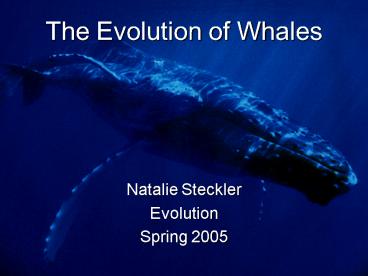The Evolution of Whales - PowerPoint PPT Presentation
1 / 19
Title:
The Evolution of Whales
Description:
Scientists currently know that modern whales evolved from terrestrial mammals. ... flippers composed of short arm bones, flat wrist bones, and five fingers ... – PowerPoint PPT presentation
Number of Views:1390
Avg rating:3.0/5.0
Title: The Evolution of Whales
1
The Evolution of Whales
- Natalie Steckler
- Evolution
- Spring 2005
2
Introduction
- Scientists currently know that modern whales
evolved from terrestrial mammals. - Some scientists link them to ungulates.
- Many transitional fossils have been found,
forming a possible lineage. - Evidence also exists in the areas of molecular
biology, embryology, morphology, and geology.
http//upload.wikimedia.org/wikipedia/en/1/14/Blue
WhaleSkeleton.jpg
3
Modern Whales
- Classification Kingdom Animalia Phylum
Chordata Subphylum Vertebrata Class
Mammalia Order Cetacea - Includes whales, dolphins, porpoises
- Give birth to live young that are nursed
- Adults have no body hair, but some newborns
exhibit temporary body hair - Over 80 species, in two suborders
4
Defining Characteristics
- Streamlined body
- Horizontal flukes and a dorsal
- fin
- Shortened neck vertebrae
- Pectoral flippers composed of short arm bones,
flat wrist bones, and five fingers - Some species have a vestigial pelvis with small
nonfunctional hind limbs - Mobile rib cage with ribs separated from
vertebral column in some species - Lengthened skull shape, nostrils on top of head,
- No tear glands, no olfactory sense, no external
opening to ear
http//www.ftexploring.com/askdrg/fbones.gif
http//images.encarta.msn.com/xrefmedia/sharemed/t
argets/images/pho/t025/T025799A.jpg
5
http//webnetworkone.com/zoobooks/images/whalebone
.gif
http//www.mbayaq.org/efc/living_species/organism_
images/lsl_mammal_m229.jpg
6
Early Speculations
- 1693- John Ray was the first to record that
whales are mammals. - 1859- Charles Darwin believed they descended
from bears (not a popular idea). - 1883- William Flower linked whales to
ungulates. - 1960s- Van Valen and Szalay used dental fossils
to link early whales to mesonychid
condylarths (extinct carnivorous
ungulates).
7
Sinonyx (60 mya)
- Primitive ungulate mesonychid in order
Condylartha - Elongated muzzle (used by whales today to hunt
fish) - Enlarged jugular foramen
- Short cranial cavity
- 44 heterodont teeth including molars with several
cusps
http//www.researchcasting.ca/images/sinonyx.jpg
http//www.talkorigins.org/features/whales/
8
Pakicetus (52 mya)
- Only fragments of the skull have been found
- Upper and lower molars have multiple cusps
premolars are triangular with a single cusp (seen
in later whales) - Narrow braincase, high narrow sagittal crest,
prominent lambdoidal crests - No vascularization in inner ear which is needed
today for deep diving - Not a land dweller but unable to swim in deep
water
http//www.talkorigins.org/features/whales/
9
http//critters.pixel-shack.com/WebImages/critters
gallery/Pakicetus.jpg
10
Ambulocetus (50 mya)
- the walking whale that swims
- 2 meters in length
- Capable of both land and sea travel
- Probably moved like sea lions on land
- Strong femur bones but only small attachment
points for leg muscles - Radius and ulna able to support weight, strong
elbows - Swam by moving spine up and down, and had large
back feet for propulsion - Toes of back feet were
- hooves
- Long tail and long
- flexible neck
- Skull had long muzzle
- No blowhole yet
http//idd02mb7.eresmas.net/images/Professional_po
rtfolio/2001/EAA/EAA_Ambulocetus_natans004.jpg
11
Rodhocetus (46 mya)
- Likely had a strong tail for swimming (spine very
flexible with large attachment points for
muscles) may have had a tail fluke - Smaller pelvis, still connected to sacral
vertebrae - Shorter femur
- Very large enlongated skull
- Teeth less differentiated than in earlier whales
- Nostrils moved back along the snout
http//www.talkorigins.org/features/whales/
12
http//www.cas.cz/ziva/cisla/0405/17.jpg
13
Basilosaurus (35-45 mya)
- Dont know if it was part of lineage that led to
modern whales - 21 meters in length
- Pelvis completely separated from spine (made
weight-bearing impossible) - Vertebral column similar to that of modern
whales may have had flukes - Nostril moved back to top of the head
http//www.dinooption.com/img06/Basilosaurus.jpg
14
http//www.mheine.com/jpeg/basilo.jpg
15
Dorudon (40 mybp)
- 5 meters in length
- Lived completely in water
- Short neck vertebrae but no apparatus for
echolocation yet - Tiny hind limbs (therefore no land travel)
http//www-personal.umich.edu/gingeric/PDGwhales/
Whales.htm
16
Overall Results of Whale Evolution
- Elongation of the skull
- Teeth became more conical
- Nostrils migrated to top of skull
- Hind limbs and pelvis became smaller and
non-functional - Hearing devices developed for underwater use
http//www.talkorigins.org/features/whales/
17
DNA Analysis
- 1985- Goodman et al. studied myoglobin, lens
alpha-crystallin A, and cytochrome sequences
from 46 species of animals - 1986- Miyamoto and Goodman studied a- and
ß-hemoglobins and ribonuclease from 72 mammal
species - Results whales are included among ungulates
http//www.ks.uiuc.edu/Research/pro_DNA/dna_w_anal
og/dna-wat.big.gif
18
Interesting Facts
- Modern whales still possess vestigial limbs such
as pelvic bones, femurs, and tibias - Modern whales develop body hair as fetuses but
dont retain that feature after birth - Whale embryos begin with nostrils at the end of
the snout which later migrate to the top of the
head - Some baleen whales have teeth in the embryonic
stage
19
References
- Hoelzel, A. Rus, ed. Marine Mammal Biology an
Evolutionary Approach. Malden, Mass Blackwell
Science, 2002. - Berta, Annalisa and James L. Sumich. Marine
Mammals Evolutionary Biology. San Diego
Academic Press, 1999. - Sarfati, Jonathan. Whale evolution? Answers
in Genesis. 2005. 17 April 2005.
http//www.answersingenesis.org/home/area/re1/chap
ter5.asp - Gingerich, Philip D. Research on the Origin and
Early Evolution of Whales (Cetacea). 2004. 17
April 2005. http//www-personal.umich.edu/
gingeric/PDGwhales/Whales.htm - Evolution of Cetaceans. Wikipedia, the free
encyclopedia. 2005. 20 January 2005.
http//en.wikipedia.org/wiki/Evolution_of_cetacean
s - Sutera, Raymond. The Origin of Whales and the
Power of Independent Evidence. The Talk
Origins Archive. 2001. 15 April 2005.
http//www. talkorigins.org/features/whales/































